Locomía: Spanish pop’s craziest story
They were aesthetically and sexually transgressive in a 1980s Spain that yearned to be modern. A new documentary reflects on their legacy, and the protagonists reconstruct the group’s wild story and confirm that their wounds remain open

It has all the elements of a familiar story: sex, betrayal, drugs, fights, death, success and a descent into hell. And it has its own particularities: handheld fans, pointed shoes, songs that became hits in Spain and Latin America, and jail. The creator of Locomía, Xavier Font, sports an ethnic-themed tattoo that covers his bald head. He had it done right after he got out of jail, after he was sentenced in 2012 to three years in prison for drug trafficking. Authorities had found ecstasy pills in his house. They also found bottles of poppers, but the substance had evaporated, so Font could not be charged for their possession. “The pills belonged to a friend. The popper bottles were mine. I sold them online to acquaintances. I am repeating the same thing that everyone in prison says, but in my case it’s true. I am innocent. It was an injustice.” Font spent three months in prison and was rewarded for good behavior: he enjoyed his freedom during the day but had to spend each night in a Barcelona detention center. When he was released in 2015, he moved to Cuba, married his mother-in-law (“so she could get her papers”) and stayed there for six years. Such a striking chain of events is typical of Font’s life.
Font joined EL PAÍS for an interview in Barcelona in the company of his husband, Harold, a 24-year-old Cuban who he married almost five years ago. “I go around the world looking for locomías” [the band’s name is a play on the words “locura mía,” or “my madness”]. But now that I am 60 years old, I hope this will be the last one,” Font explains in a hoarse voice. An upcoming Movistar Plus+ documentary, which premieres on June 22, retells Locomía’s extraordinary story. Titled simply Locomía, and subtitled “the greatest soap opera ever danced,” the film, directed by Jorge Laplace, consists of three 45-minute episodes. It features twenty-some voices, and Font’s story forms the backbone of the film. Sitting in a hotel in the center of Barcelona, where he lives, Font says that he wants to turn his husband into the next locomía, although Harold acts fidgety. “We’ll see, we’ll see…,” the young Cuban hems and haws. “He is my last dragon. I am a headhunter. I see potential artists. I’m a fucking fantasy maker. That’s how it all started,” says Font.
That’s not quite how it all started, though. Xavier’s father and mother were rural landowners. Their six sons enjoyed a comfortable life in the family’s sprawling farmhouse in Sant Boi. “We had all shiny new things. My father squandered a fortune at the casino. He was a gambler. With my mother I always got along well and received a lot of love. Both of them accepted my sexuality without any trouble. I was never in the closet. My father would come into my room and see me with my boyfriend. He took it in stride,” he says. He bought fabrics at the Mercat dels Encants and made tunics, jackets and coats. He was influenced by the style of early-eighties British New Romantic bands, including Duran Duran, Depeche Mode and Spandau Ballet. But he took everything to the extreme: shoulder pads went XXL. One day, at an museum, Font noticed some pointed shoes from the 14th century and went wild. He made his own. He didn’t want to be a designer: he created clothes for himself, then wore them in the most modern places in Barcelona. He liked to attract attention. He wanted all eyes on him. “The shoes were key. People couldn’t stop looking at them.”

Font settled in Ibiza in 1984 seeking to create a subculture scene. He had met a Dutchman, Gard Passchier, with whom he had a relationship, as well as Manuel Arjona, a young man from a conservative family of 10 siblings. Over the phone, Arjona says, “When I arrived in Ibiza it seemed like another planet. I came from Viladecans, where I had to hide my sexual identity. And on the island, if you were a boy and you wore a skirt, no one even looked at you. It was a wild change.” And he recalls that “at that time, Font had a great power of seduction, both professionally and personally.” Font had romantic relationships with both Gard and Manuel. But they needed one more locomía: the ringleader’s brother, Luis Font. The four settled in a house in Ibiza. They designed their flashy outfits and went to the trendy nightclub Ku. They began to attract attention, and the owners hired them. They were paid a million pesetas a month (€6,000 at the time). What was their job? Dancing on tables, showing off, flirting. They performed a dance with fans, which Font designed after seeing some gay New Yorkers dance in a venue in Sitges: “They had small fans, and I noticed a movement that captivated me. I got home and started building. As I am an exaggerated I invented the XXL fans. I got the movement with nine rods that I took from the material of one of my brothers, who worked in model airplanes. I made some holes and used my mother’s sheets.” Font had a nose for business, and he began registering everything legally: the shoes, the suits, the fans, the name Locomía.
The group of Ibiza locomías grew to 16, between members of the quartet who came and went, designers and secretaries. They functioned as a commune. Font was a lover of several of them, sometimes simultaneously. “I had a harem and I invented polyamory in 1984. I could never get enough. Today it’s sad to say, but while I was in a relationship with Manolo and Gard, I was going home with another new guy. I was the forerunner of the whole movement and had a lot of unpaid employees. Of course, they did not lack anything,” he points out without blushing.
The timing was important. Spain’s ruling Socialist Party (PSOE), in government since 1982, was seeking to offer a modern and unprejudiced image of Spain. Madrid’s countercultural movement, La movida, was in full swing, and director Pedro Almodóvar had just released his fourth film, his most successful to date, What Have I Done To Deserve This?. Locomía had a place in this movement, particularly because they were based in hedonistic Ibiza. They represented an aesthetic and sexual freedom that captivated young people in search of references outside of their oppressive classical education. Newspapers covered the rise of Locomía, and they became an attraction on the island that was frequented by stars including Harrison Ford, Grace Jones, Boy George and Freddie Mercury. During a 1987 birthday visit by the Queen frontman, the singer showed up at the boutique that Font had opened in Ibiza. He bought two suits at $1,000 apiece, and Font gave him a pair of his famous pointy shoes. Mercury liked them so much that he wore them in one of his last videos with Queen, the 1991 I’m Going Slightly Mad.

After four successful summers at Ku, the group needed to leave the island. Manuel Arjona was having serious drug problems. Their house burned down with all the costumes inside (Font suggests that the fire was caused by people jealous of Locomía’s success). And the dance and modeling group received an offer to become singers. José Luis Gil, then president of major recording company Hispavox, appeared on the scene. He was behind Locomía’s ascent.
Gil had notable experience discovering artists and getting their careers off the ground. He had worked with Miguel Bosé, Enrique and Ana, Rafaella Carrá, Nacha Pop, Alaska and José Luis Perales, all household names in Spain. He was known for his nose for future stars. Gil discovered Locomía after attending one of their shows in Ibiza. “I like your visual concept,” he told them. “Have you considered the possibility of singing?” They reached an agreement.
Gil’s mission was to turn Locomía’s anarchy into a business. Today, Gil describes the project over the phone: “After four years in Ibiza rubbing shoulders with the most modern folks in Europe, Locomía was just a commune of entertainers directed by a leader of dubious morality who had their house burned down and were expelled from Ku. My offer to turn them into a music group saved them from separating.” And the conflicts began between Font and Gil, two incompatibly strong personalities.

Gil won the first battle. Font left the group (“I didn’t like to dance and wear the clothes that Gil told me to wear”), but he kept the brand and continued receiving a salary. The group had to have four members at all times, so Font was replaced. “People think we were just four handsome, tall boys. But there is a lot of work behind that. When Gil arrived, we spent two years taking dance and singing classes. We became professionals. We never stopped working,” explains Arjona. Gil signed on the producer Pedro Vidal, and they began to make music. The first album, Taiyo (1989), was a hit. Its songs included Locomía (with its famous line “Disco, Ibiza, Locomía, moda, Ibiza, Locomía, sexy, Ibiza, Locomía”) Rumba Samba Mambo and Gorbachov. “The idea was to create a Spanish-language band who played dance music, since there was nothing like that at the time,” says Gil. Javier Adrados, biographer of Mecano and La Unión, was at the launch of the first album in Madrid: “What we saw that night at [Madrid nightclub] Joy Eslava was very relevant. Absolutely modern. There were some cultural phenomena in Spain, such as Almodóvar or Alaska, who opened a thousand and one closets, but Locomía was the definitive door to an ideal world that until then hadn’t existed. For the first time, gay power took over all the dance floors and, more importantly, the festivals in the most remote towns in Spain.”
Gil advised the group members to be ambiguous when talking about their sexuality. “But I never restricted their freedom,” he emphasizes. The group was a perfect fit for variety shows hosted by TV stars of the day like Concha Velasco and José Luis Moreno, who drew large audiences. As Gil’s group ascended, Font grieved (“I had left my herd in Gil’s hands”), brooded over his revenge and continued to get paid for doing nothing.
Under Gil’s guidance, the quartet made the leap to Latin America. From Argentina to Mexico to Peru, they ignited a craze. Hundreds of girls waited outside airports for their arrival. Fans climbed the walls of their hotels and burst into tears at their concerts. Teenagers snuck into their beds. Gil’s strategy of keeping the band members’ sexual orientations quiet had had worked: 80% of the fans were female. After the second album, Loco Vox (1991), came out, Gil received a hefty contract to enter the United States market. Since Font was based in Miami, Gil decided that he should handle the matter. That’s when the bomb exploded. It was 1992. The iconoclast once again employed his power of seduction: Font convinced the four of them to break the contract with Gil. “Gil was stealing from us,” Font argues. “And I felt screwed because Gil had taken my boys from me, and I wanted to screw him over.” Gil contests Font’s account: “The boys’ lack of experience gave Font an unhealthy control, which he exercised thinking only of his ego and his own benefit. We learned in a fax from Miami that the group was leaving the company and breaking their commitments.”

Manuel Arjona still regrets that decision today. “We were ungrateful to Gil. It was a big mistake to break the contract. That ended the group. We were four kids who let ourselves be fooled by Font.” But the war had only begun. Gil, who owed the record company another album like Locomía, recruited three new guys, who joined Luis Font, Xavier’s brother. “My brother is the Darth Vader of Locomía. He went over to the dark side out of ambition and power,” says Luis about Xavier, justifying his decision. For almost a year, two Locomías battled each other through concert boycotts, calls to industry bosses and lawsuits. The battle culminated in an iconic pop culture moment: Gil’s Locomía was slated to perform on a major Mexican television program, Siempre en Domingo. Fans, encouraged by Font on the phone from Miami, grabbed one of the members by the hair until he bled. Everything was broadcast live.
In Locomía’s lowest moments, the group became the target of homophobic mockery. Both versions of the group fell apart, and Locomía’s career came to an end in 1993. The group’s fall coincided with the first cracks in modern Spain: unemployment, corruption and demonstrations occupied more and more space on the news.
The war between Gil and Font continues to rage. Font owns the group’s name, and Gil owns the songs. Locomía’s members have been replaced over and over, and their performances are inconsistent–not to mention other misfortunes: in the summer of 2018, two members, 46-year-olds Santos Blanco and Frank Romero, died one month apart. Gil has warned Font against using the songs’ recordings, which he owns, in concerts. Locomía has been lipsynching in their performances for some time. “If he continues with that attitude, I will sue him,” threatens Gil, who is ambivalent about the Movistar documentary, in which he appears. “There is little music and plenty of sensationalism. That’s why I’ve asked for my name to be removed as an associate producer.”
Manuel Arjona may be the key character in this story. He was the first locomía, and he has been involved in the project for 35 years. “I have felt used by Font. For him, Locomía is just a business. For me it is work, but it is also my life. The history of Locomía is a group effort. It would not have happened without everyone’s contributions. Five years ago, I had to quit because I wasn’t earning money and I had to take care of my parents.” His father died a year ago, and now he takes care of his 98-year-old mother. Arjona, now 55, is in negotiations with Font for future projects. “But we have to talk. I cannot be an employee of Locomía. We have to be partners.”
Font, for his part, trusts that the documentary will reactivate Locomía with him at the helm and with the faces of four new young men. “I also have signed for a reality show in Miami to look for the four ideal locomías. But what I really want is to go to Eurovision. And above all, I am owed a Grammy. I’m not going to stop until I get it,” he says, waving his ringed hands. The fan clubs that still survive in Spain and Latin America cling to a hope: the locomías are condemned to get along, even though they haven’t succeeded in three decades.
Tu suscripción se está usando en otro dispositivo
¿Quieres añadir otro usuario a tu suscripción?
Si continúas leyendo en este dispositivo, no se podrá leer en el otro.
FlechaTu suscripción se está usando en otro dispositivo y solo puedes acceder a EL PAÍS desde un dispositivo a la vez.
Si quieres compartir tu cuenta, cambia tu suscripción a la modalidad Premium, así podrás añadir otro usuario. Cada uno accederá con su propia cuenta de email, lo que os permitirá personalizar vuestra experiencia en EL PAÍS.
¿Tienes una suscripción de empresa? Accede aquí para contratar más cuentas.
En el caso de no saber quién está usando tu cuenta, te recomendamos cambiar tu contraseña aquí.
Si decides continuar compartiendo tu cuenta, este mensaje se mostrará en tu dispositivo y en el de la otra persona que está usando tu cuenta de forma indefinida, afectando a tu experiencia de lectura. Puedes consultar aquí los términos y condiciones de la suscripción digital.
More information
Últimas noticias
Most viewed
- Alain Aspect, Nobel laureate in physics: ‘Einstein was so smart that he would have had to recognize quantum entanglement’
- Mexico’s missing people crisis casts a shadow over World Cup venue
- Why oil has been at the center of Venezuela-US conflicts for decades
- Trump clarifies who is ultimately in charge in Venezuela: ‘Me’
- Mexico seeks to shore up its defenses following US incursion in Venezuela










































